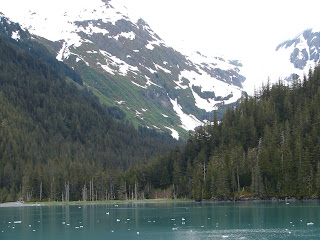Glacier Cruising on Prince William Sound
 Our cruise with Stan Stephens Company took us from Valdez (bottom right pink) to Meares Glacier (bottom left pink) back to Columbia Glacier (middle lower pink). The bottom pink is Bligh Reef where the Valdez Exxon ran aground in 1989.
Our cruise with Stan Stephens Company took us from Valdez (bottom right pink) to Meares Glacier (bottom left pink) back to Columbia Glacier (middle lower pink). The bottom pink is Bligh Reef where the Valdez Exxon ran aground in 1989.
Above is a panoramic of Columbia Glacier. The Columbia Glacier was the last of Alaska's tidewater glaciers to go into a retreat. The retreat began in 1978, and by 1983 it had moved off its terminal moraine, losing an increasing amount of ice. In 2002, it had retreated a distance of 7 1/2 miles, leaving approximately 18 miles to go before reaching bedrock on shore. This retreat is truly "history in the making."
Before the whale appears he makes a blow; next

Humpback Whales are baleen feeders, consuming nearly a ton of food a day, mostly
plankton and krill. They migrate 6,000 miles twice a year. They are an average of 45 feet & weigh 35-40 tons.

you will see a fin and whale back pop up, and if
you are very, very lucky, the prized "whale tale" can be photographed.




Steller Sea Lions average 1,200 pounds for the males and up to 650 for females. They eat during the night, sunning and resting on rocks during the day. They generally live in colonies and are known to be very boisterous.


There was very interesting interaction about to take place between the bull and his harem on the rock and the huge bull about to crawl onto the rock from the right side.

And boy there was a lot to be said between them!



Approaching Columbia Glacier




In Alaska there are 30,000 square miles of glacier ice, covering 5% of the state. Glacier ice is blue because the physical properties of the water molecule absorbs all of the colors in the spectrum except the blue, which is transmitted. Glaciers in the Sound are both retreat--shortening the distance from the origin to the terminus--and advancing, increasing in size.


Sea Otters are known as the "Old man of the sea". They are the largest members of the Weasel family in North America. The males weigh up to 100 pounds. When not eating, consuming nearly 25% of their weight daily, they float on their backs, grooming, resting and generally enjoying life. They are fun creatures to watch as they carry their babies on the stomach (above) and tumble and turn playfully in the water. And they do love to perform for an audience.




It was Jerry's most fervent wish to lick glacial ice. Mission accomplished!



you are very, very lucky, the prized "whale tale" can be photographed.




Steller Sea Lions average 1,200 pounds for the males and up to 650 for females. They eat during the night, sunning and resting on rocks during the day. They generally live in colonies and are known to be very boisterous.

There was very interesting interaction about to take place between the bull and his harem on the rock and the huge bull about to crawl onto the rock from the right side.

And boy there was a lot to be said between them!



Approaching Columbia Glacier




In Alaska there are 30,000 square miles of glacier ice, covering 5% of the state. Glacier ice is blue because the physical properties of the water molecule absorbs all of the colors in the spectrum except the blue, which is transmitted. Glaciers in the Sound are both retreat--shortening the distance from the origin to the terminus--and advancing, increasing in size.


Sea Otters are known as the "Old man of the sea". They are the largest members of the Weasel family in North America. The males weigh up to 100 pounds. When not eating, consuming nearly 25% of their weight daily, they float on their backs, grooming, resting and generally enjoying life. They are fun creatures to watch as they carry their babies on the stomach (above) and tumble and turn playfully in the water. And they do love to perform for an audience.




It was Jerry's most fervent wish to lick glacial ice. Mission accomplished!


Harbor Seals have round heads and large eyes and are not as social as sea lions. Females with pups are seen up on the ice bergs near glaciers. They dive up to 600 feet to retrieve their food. With their short front flappers, they are not agile or safe on land. We have some Harbor Seals near us in camp. They generally only stick their heads out of the water for a short time but those huge eyes are so compelling, you fall in love instantly.

This piece of glacier cracked and broke off when we were there to see it. Amazing sound and sight. The blue colors are stunning!
there were so very many pictures to choose from; it was hard to cull them down to a few. Hope you enjoyed those you did see.

This piece of glacier cracked and broke off when we were there to see it. Amazing sound and sight. The blue colors are stunning!
there were so very many pictures to choose from; it was hard to cull them down to a few. Hope you enjoyed those you did see.
BBYN, Karen and Don

1 Comments:
Awesome pictures, Karen! We went to Alaska about 10 years ago and seeing all of these definitely makes us want to go back ;-)
Happy Travels, Cindi & Steve
Post a Comment
Subscribe to Post Comments [Atom]
<< Home